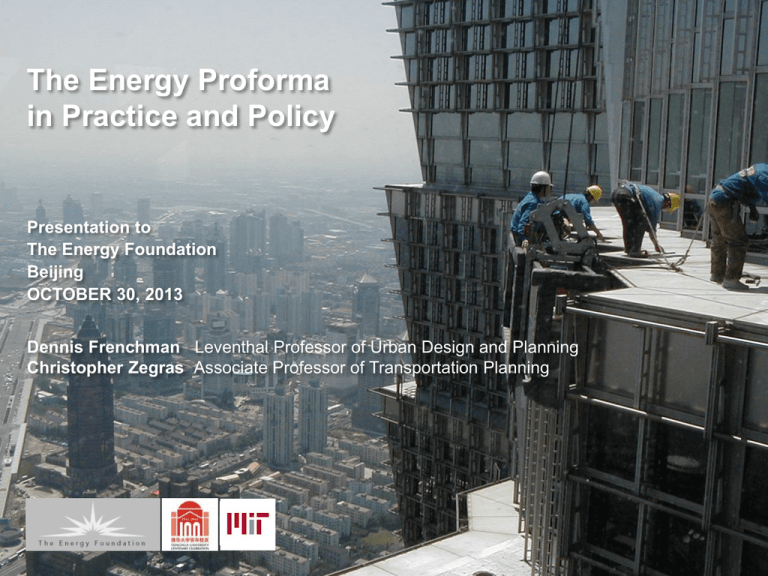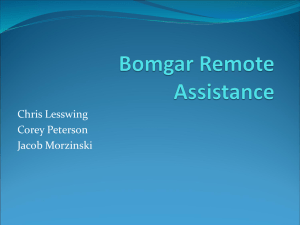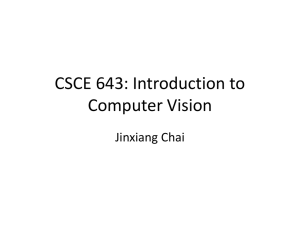
© 2012 MIT, all rights reserved
The Energy Proforma
in Practice and Policy
Presentation to
The Energy Foundation
Beijing
OCTOBER 30, 2013
Dennis Frenchman Leventhal Professor of Urban Design and Planning
Christopher Zegras Associate Professor of Transportation Planning
© 2012 MIT, all rights reserved
2012-2013 PROJECT TEAM
Principal Investigators
Supported by EF and MIT:
Supported by MIT:
Supported by
EF, LCEUA & MIT:
© 2012 MIT, all rights reserved
2012-2013 PROJECT DEVELOPMENTS
MODELING &
SIMULATION
FOR IN-HOME &
TRANSPORT ENERGY
ENERGY
PROFORMA
POLICY
PROPOSALS
& CHALLENGES
IN PRACTICE
PAPERS:
Simulation of Household
In-home and Transport
Energy Use:
An integrated behavioral
model for estimating energy
consumption at the
neighborhood scale
The Energy Proforma:
Measuring neighborhood
energy performance for
design, development, and
urban policy
Neighborhood Energy
Performance Policy for
China
Implementing EnergyEfficient Neighborhood
Form in China
© 2012 MIT, all rights reserved
INCORPORATING FEEDBACK FROM
ACADEMICS & STAKEHOLDERS
• MIT-Tsinghua Joint Studio surveys &
interviews
June 2012
• Interviews with 20 urban planning
professionals in Shenzhen and Jinan
Jan-Dec 2012
• Kunming Chenggong planning delegation &
EF symposium at MIT
January 2013
• Lincoln Land Institute – Peking University
RUSE conference
June 2013
• Mayoral training program by American
Planning Association, held at MIT
July-Sept 2013
© 2012 MIT, all rights reserved
CHINA IN 2030:
300 MILLION NEW URBAN RESIDENTS
30,000 NEW SUPERBLOCK DEVELOPMENTS
TOWER SPRAWL:
IS IT SUSTAINABLE?
McKinsey Global Institute Preparing for China’s Urban Billion March 2009
© 2012 MIT, all rights reserved
ENERGY PERFORMANCE @
THE NEIGHBORHOOD SCALE
• Neighborhood = fundamental unit of urban development
• Evidence of measurable relationships between energy use and urban form
• Measurable & manageable energy performance (using Energy Proforma)
• Opportunity for improving energy efficiency through
• Urban development regulation and land policies
• Real estate market transformation strategies
© 2012 MIT, all rights reserved
OBJECTIVES
调查规模
Scales of Investigation
目标
Metro scale
1. 探索邻里尺度的能源
消耗和城市形态之关系
1:20,000
城市尺度
Explore relationships
between energy and
urban form at the
neighborhood scale
Urban development scale
1:1000
2.
开发新的用于分析、
设计以及能源使用相关
政策的工具
Develop new tools for
analysis, design, and policy
related to energy use in
neighborhoods
社区开发尺度
Building scale
1:50
建筑尺度
7
© 2012 MIT, all rights reserved
INTEGRATED APPROACH
综合的路径
20.Driving is a sign of prestige
21.Having too many cars is the main reason of traffic congestion
22.Taking public transit is convenient
23.I enjoy bicycling
24.Time spent traveling is wasted time for me
25.Transportation convenience is important in choosing the residence
26.I prefer living around people who are similar to me
27.Living in a gated community is a sign of prestige
28.I think gated community provides better security
29.I prefer to have shops and services such as laundry, barber and restaurants
30.My family pays close attention to saving water, gas or electricity
1
1
1
1
1
1
1
1
1
1
1
2
2
2
2
2
2
2
2
2
2
2
3
3
3
3
3
3
3
3
3
3
3
4
4
4
4
4
4
4
4
4
4
4
5
5
5
5
5
5
5
5
5
5
5
城市设计
Urban Design
人的活动
Human Activity
数字化的
能源工具
Digital
Energy
Tool
© 2012 MIT, all rights reserved
ENERGY PROFORMA CONCEPT
© 2012 MIT, all rights reserved
JINAN: DEMONSTRATION CITY
济南:案例城市
© 2012 MIT, all rights reserved
URBAN FORM IN JINAN AND CHINA
济南及中国的城市形态
Traditional
Fabric
传统结构
Urban
Grid
城市网格
Low-rise
Slab/Enclave
低层排楼/聚集区
High-rise
Superblock
高层超大街区
© 2012 MIT, all rights reserved
城中村(张家村)
传统结构
(芙蓉)
城市网格
(旧CBD)
超大街区
(阳光100)
聚集区
(佛山院)
© 2012 MIT, all rights reserved
TOTAL ANNUAL ENERGY USE OF NEIGHBORHOODS
邻里的年度总能耗
© 2012 MIT, all rights reserved
INTEGRATED IN-HOME/TRANSPORT
MODEL FRAMEWORK
© 2012 MIT, all rights reserved
SOCIO-ECONOMIC
AND EQUIPMENT
OWNERSHIP
INDICATORS
家庭社会经济属性
及电器/机动车拥有情况
Single
Couple
Family Structure
Couple & kids
Couple & parents
(家庭结构)
Grandparents & grandchild
Three generations
1
2
Household Size
3
(家庭大小)
4
>4
Min
Annual Income (Yuan)
Max
Mean
(家庭年收入)
Std.
0
Air Conditioner
1
(空调)
>1
No vehicle owned
E-bikes only
Vehicle Portfolio
Motorcycles
(机动车拥有)
Cars only
Cars and other vehicles)
6.68%
23.64%
42.11%
4.76%
2.92%
19.97%
4.90%
25.30%
40.90%
16.70%
12.20%
4300
720000
93066
74756
12.7%
36.7%
50.6%
30.6%
23.9%
5.2%
24.1%
16.2%
© 2012 MIT, all rights reserved
ATTITUDES INDICATORS
住户态度指标
开车是名望的表达式 Driving is a sign of prestige
34.0%
坐公共交通很方便It is convenient to take buses
67.5%
我喜欢骑自行车 I like riding bicycles
53.7%
坐交通的时间是浪费时间 Time spent on travel is a waste to me
35.6%
我宁肯住在较大的房子 I’d like to live in bigger house
55.2%
我喜欢旅游 I like traveling
66.7%
超市的塑料袋子应该免费的 Plastic shopping bags should be free
50.6%
达官出外不坐公交车也不骑自行车
High-rank officials do not take buses or ride bicycles to go out
有钱的人出外不坐公交车也不骑自行车
Rich men do not take buses or ride bicycles to go out
我经常户外健身 I exercise regularly outside
塑袋及塑料瓶子都再使用 I reuse things like plastic bottles or bags
57.9%
52.4%
62.3%
69.3%
© 2012 MIT, all rights reserved
NEIGHBORHOOD FORM VARIABLES
城市形态的变量
密度
Density
Residential Density
Building coverage
Building mass porosity
多样性
Diversity
Building function mix
Land use mix within 500m
Street level shops
设计
Design
Neighborhood size
Green coverage
Continuity of street façade
Motorway width
Southern exposure index
Surface-to-volume ratio
可达性
Accessibility
Building footprint size
Distance btw entries
Parking provision
Streets with sidewalks
Road density
Cul-de-sacs
Bus Rapid Transit routes
位置
Location
Distance to city center
Regional accessibility
© 2012 MIT, all rights reserved
NEIGHBORHOOD FORM VARIABLES
城市形态的变量
Wind Porosity
多孔性
Solar Exposure
朝南指数
Surface-to-Volume
表面体积比
Site Coverage
建筑覆盖率
Density
Residential Density
Building coverage
Building mass porosity
Diversity
Building function mix
Land use mix within 500m
Street level shops
Design
Neighborhood size
Green coverage
Continuity of street façade
Motorway width
Southern exposure index
Surface-to-volume ratio
Accessibility
Location
Building footprint size
Distance btw entries
Parking provision
Streets with sidewalks
Road density
Cul-de-sacs
Bus Rapid Transit routes
Distance to city center
Regional accessibility
ModeDistance
Internal/
External
Trip
Frequency
In-home
Energy
Electricity
Lifestyle
Trade-off
Vehicle
RELATIONSHIPS
IN MODELS
Appliance
© 2012 MIT, all rights reserved
© 2012 MIT, all rights reserved
SIMULATION: SENSITIVITY ANALYSIS
In-home
Porosity ↓10%
Transport
Residential density
↑20 HH/acre
2%
1.9%
Southern orientation
index ↑10%
% energy savings in year 1
% energy savings in year 10
7.5%
7.2%
9.5%
10.7%
Street level shops
↑20%
Function mix
↑10%
Streets with
sidewalks ↑20%
7.5%
7.2%
2.0%
8.1%
0.6%
3.3%
Continuity of building
façade ↑10%
Continuity of street façade: 10% X
Continuity of street façade: 80%
11.4%
12.4%
© 2012 MIT, all rights reserved
SIMULATION: PREDICTION IN 20 YEARS
10000
10000
COMMERCIAL GRID
第1年
TRADITIONAL
第10年
8000
第1年
第10年
8000
第20年
第20年
6000
4000
4000
2000
2000
0
0
MJ
6000
电动车
摩托车
小汽车
电动车
公交车
摩托车
小汽车
公交车
10000
10000
6-STORY ENCLAVE
8000
SUPERBLOCK
第1年
第10年
第1年
第10年
8000
第20年
第20年
6000
4000
4000
2000
2000
0
0
MJ
6000
电动车
摩托车
小汽车
公交车
电动车
摩托车
小汽车
公交车
© 2012 MIT, all rights reserved
ENERGY PROFORMA 2.4: USED IN BEIJING STUDIO 2012
2
Real-time
adjustments of
neighborhood
form measures
1
Visual feedback
on overall
energy use
3
Detailed text
output
© 2012 MIT, all rights reserved
MIT-TSINGHUA 2012 JOINT STUDIO ASSESSMENT:
Feedback from students and collaborators in Beijing
How strong is the
relationship between
energy use and
neighborhood form?
(Before studio -> After)
Assessment of
Proforma’s impact on
studio learning
objectives
(Before studio -> After)
1
Understanding of overall energy
use in neighborhood:
Improvement in almost all students
2
3
Understanding of impacts
of specific design choices:
some students improved
© 2012 MIT, all rights reserved
ENERGY PROFORMA 3.0: DEVELOPMENT IN 2012-2013
ENERGYPROFORMA.mit.edu
© 2012 MIT, all rights reserved
DEVELOPING AN INTEGRATED PLATFORM FOR
URBAN STAKEHOLDERS
© 2012 MIT, all rights reserved
ENERGY PROFORMA FOR DESIGNERS:
RAPID PROTOTYPING OF CLEAN ENERGY NEIGHBORHOODS
© 2012 MIT, all rights reserved
DETAILED ANALYSIS OUTPUT PER ENERGY DIMENSION
© 2012 MIT, all rights reserved
ENERGY PROFORMA FOR DESIGNERS:
PERFORMANCE COMPARISON ACROSS DESIGN OPTIONS
© 2012 MIT, all rights reserved
ENERGY PROFORMA FOR DEVELOPERS:
LIFECYCLE COST INCLUDING ENERGY CONSUMPTION
© 2012 MIT, all rights reserved
ENERGY PROFORMA FOR PLANNING BUREAU:
REGULATORY PLAN ENERGY PERFORMANCE ANALYSIS
BASED ON FEEDBACK FROM KUNMING/EF DELEGATION (JANUARY 2013)
© 2012 MIT, all rights reserved
© 2012 MIT, all rights reserved
DEVELOPING AN INTEGRATED PLATFORM FOR
URBAN STAKEHOLDERS: SUMMARY
CURRENT FEATURES:
COMING SOON:
• Open access
(anyone can try it)
• Transparent back-end engine
(with integrated documentation)
• Rapid analysis of
neighborhood development
and regulatory plans
• Extensible back-end models
and/or data via API
• Information and design model
repository for low carbon
urban design
• Detailed feedback on
neighborhood form measures
(decision support for
designers)
• Simulation with population
generation and changes in
neighborhood form
• Detailed analysis of energy/fuel
sources
• Improved usability (better
geometry input)
• Financial analysis (lifecycle cost)
© 2012 MIT, all rights reserved
USING THE PROFORMA TO EVALUATE
POLICY PROPOSALS ACROSS 3 DOMAINS:
Regulation
Municipal Finance
Market Transformation
Prescriptive
Guidelines
Land Lease
Modification
Energy Disclosure
& Labeling
Performance
Standard
Property
Taxes
Carbon Emission
Trading
© 2012 MIT, all rights reserved
BASIS IN CHINA CITY PILOT PROGRAMS
Regulation
Prescriptive
Guidelines
SHENZHEN etc.
green building
guidelines
Performance
Standard
(Some eco-city
indicators; national
building EE standard)
Municipal Finance
Land Lease
Modification
TIANJIN & NANCHANG
green building &
infrastructure lease
requirements
Property Taxes
CHONGQING &
SHANGHAI
tax pilot for public
housing
Market Transformation
Energy Disclosure
& Labeling
SHANGHAI
Commercial/public
building database
Carbon Emission
Trading
GUANGZHOU &
CHONGQING
verified emissions
reductions and
carbon tickets
© 2012 MIT, all rights reserved
INDICATORS/CRITERIA IN CURRENT CODES (from December)
REGULATION
U
R
B
A
N
N
E
I
G
H
B
O
R
H
O
O
D
urban development land per capita
residential land per capita
public services land per capita
Land use
street and transportation land per capita
green space per capita
park land per capita
composition of urban development land
grid density
means of transportation
Streets and
width of urban roads
transportation accessbility to public transportation
Green space rate
green space
Plants requirements
public green space per-capita
green roof ratio
paving and roads area ratio
accessbility: entraces
road density
Streets and
bike lane
transportation width of roads
other requirements on roads
parking space per capita
ground-floor parking space ratio
residential land ratio
residential land per capita
total scale of population and households
residential buildings insolation interval
building interval
Density Control building height
building density
building façade ratio
Floor area ratio
window-wall ratio
building covering area
public facility space per capita
Service and
public service accessibility
Infrastructure
permeable flooring ratio
garbage recycling ratio &classify
water recycling ratio
Recycle,
renewable clean energy ratio
energy use
origin of material
urban land use and
planning standards of
development land
Code of urban Residential
Areas Planning & Design
Green ecological
neighborhood Technical
indicators
Evaluation Standard
for Green Buildings
Green Building
Guideline SZ
© 2012 MIT, all rights reserved
ENERGY-BASED GUIDELINES
© 2012 MIT, all rights reserved
ENERGY-BASED GUIDELINES:
ACCESSIBILITY
CONVENTIONAL
LOW-CARBON
© 2012 MIT, all rights reserved
NEIGHBORHOOD ENERGY PERFORMANCE STANDARD
指令性的
Prescriptive
设计阶段
Design Before
管理阶段
Analysis After
生态城市规范
Eco-city Regulations
生态城市规范
Eco-city Regulations
基于能源的导则
Energy-based Guidelines
生态城市指标
Eco-city Indicators
能源绩效计算器预测
绩效性的
Performance Energy Proforma Estimation
生态城市指标
Eco-city Indicators
能源绩效计算器分析
Proforma Analysis
© 2012 MIT, all rights reserved
NEIGHBORHOOD ENERGY PERFORMANCE STANDARD
© 2012 MIT, all rights reserved
MUNICIPAL FINANCE REFORMS:
LAND LEASE MODIFICATIONS AND PROPERTY TAXES
TO SUPPORT CLEAN ENERGY NEIGHBORHOOD DEVELOPMENT
@ 1% of market value per
annum on new residential
© 2012 MIT, all rights reserved
NEIGHBORHOOD ENERGY LABELING AND DISCLOSURE
HIGH ENERGY USE
AVERAGE
LOW
© 2012 MIT, all rights reserved
NEIGHBORHOOD ENERGY LABELING AND DISCLOSURE
Adapted from Nadkarni, Nikhil, and
Harvey Michaels. 2012. “A New Model
for Disclosing the Energy Performance
of Residential Buildings.”
© 2012 MIT, all rights reserved
CARBON TRADING FOR NEIGHBORHOODS
Chen Demin, Tan Zhixion - 2012 – “Establishment of Regional Carbon
Trading Market: A Case Study of Chongqing”, 重庆市碳交易市场构建研究
© 2012 MIT, all rights reserved
NEIGHBORHOOD ENERGY EFFICIENCY CERTIFICATES
FOR EMISSIONS TRADING SCHEMES
© 2012 MIT, all rights reserved
INTEGRATED POLICY SUPPORT FOR
CLEAN ENERGY NEIGHBORHOOD DEVELOPMENT
Regulation
Municipal Finance
Market Transformation
Prescriptive
Guidelines
Land Lease
Modification
Energy Disclosure
& Labeling
Performance
Standard
Property
Taxes
Carbon Emissions
Trading
Neighborhood standards
for “eco-city” programs
Government official
evaluation metrics
Full neighborhood rating &
professional accreditation
Green Loans
Neighborhood ESCOs &
cooperation with UDICs
© 2012 MIT, all rights reserved
PRESENTATION SUMMARY
MODELING&
SIMULATION
ENERGY
PROFORMA
POLICY
PROPOSALS
• Integrated
behavioral
modeling of inhome & transport
energy use
• Microsimulation
framework for
future transport
use and energy
consumption
Rapid neighborhood
energy assessment
can be part of
workflow for:
• Designers
• Developers
• Planning bureau
• Policymakers
• Prescriptive codes
• Neighborhood
Energy Performance
Standard (NEPS)
• Municipal finance
reforms (land lease
& property taxes)
• Market strategies
(energy labeling &
carbon trading)
ENERGYPROFORMA.MIT.EDU
Making the Clean Energy City in China







